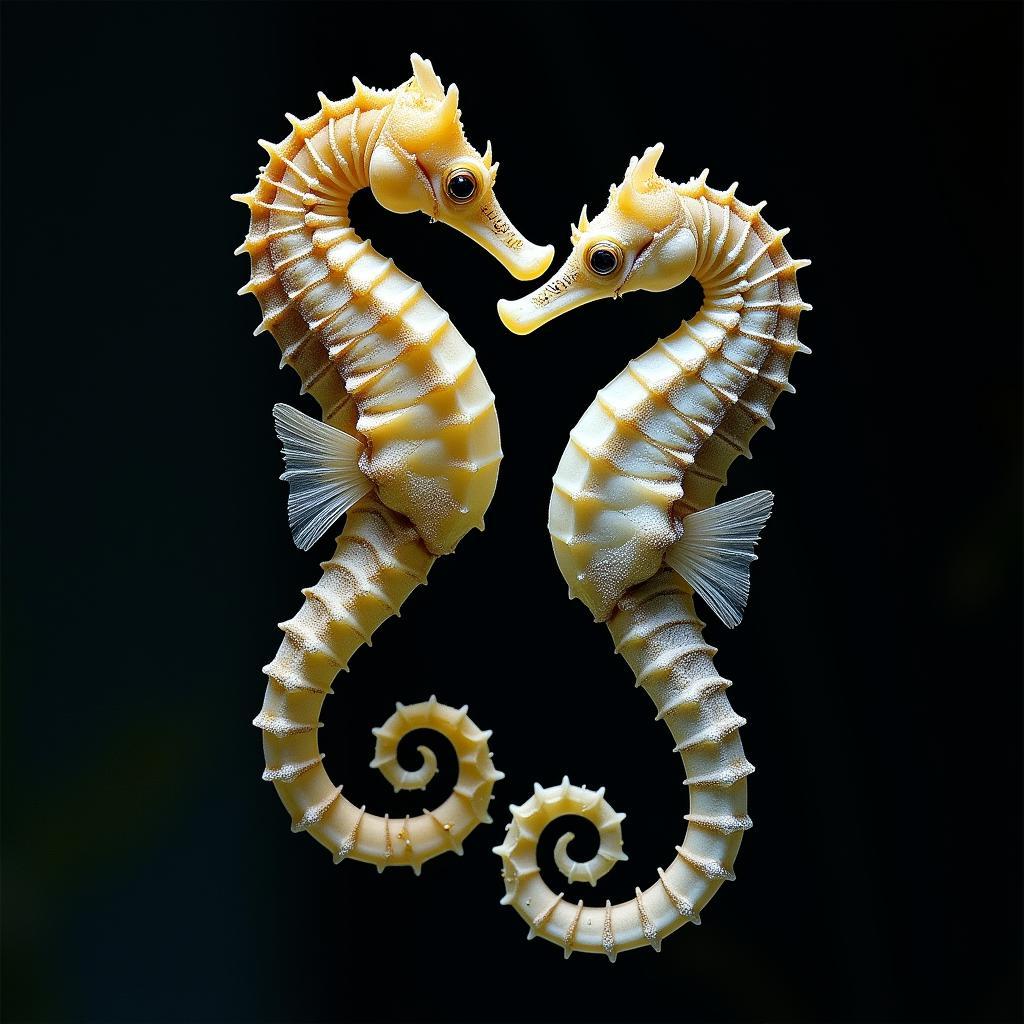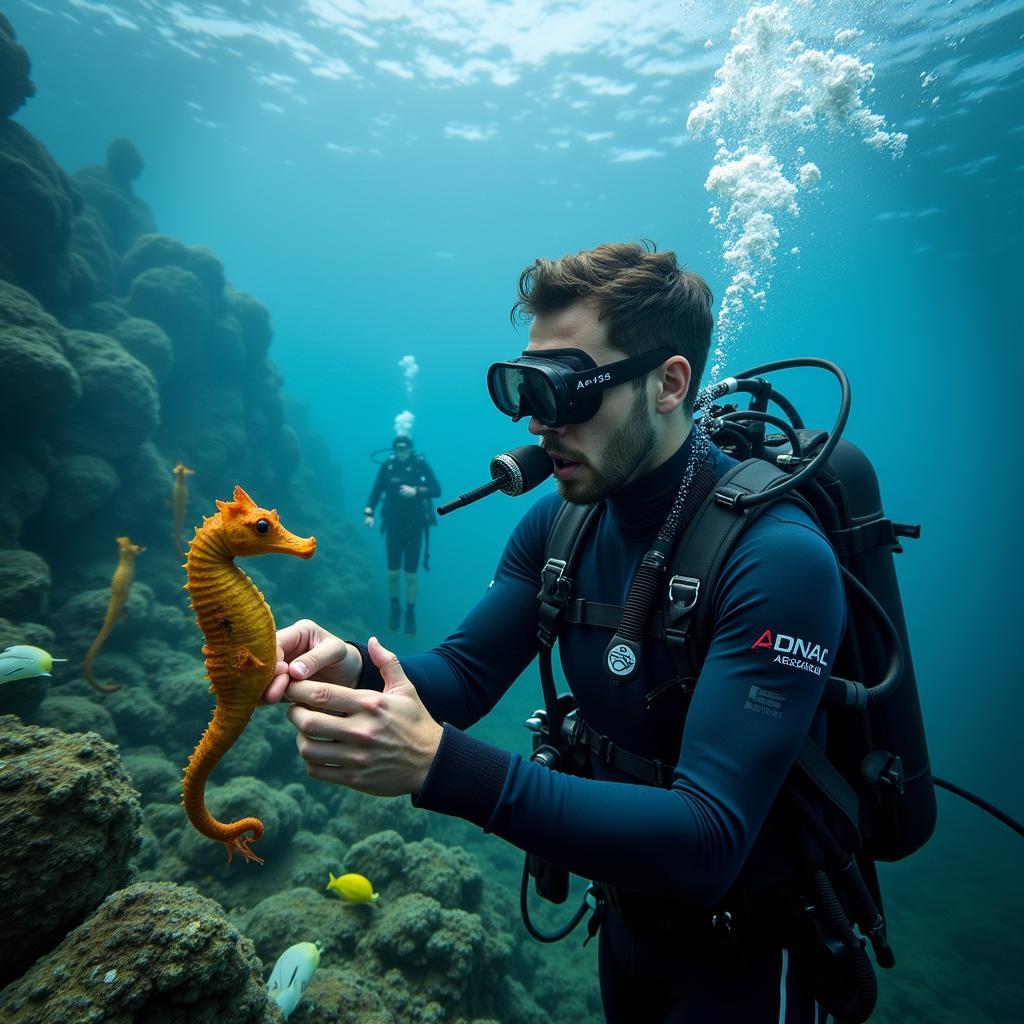The seahorse, a captivating creature found in tropical and subtropical waters around the world, is a testament to nature’s creativity. These tiny fish, instantly recognizable by their unique equine shape, are a marvel of evolution, boasting a fascinating array of characteristics that set them apart from any other inhabitant of the ocean.
A Fish Unlike Any Other: Understanding the Seahorse Anatomy
 Seahorse Anatomy: Key Features Explained
Seahorse Anatomy: Key Features Explained
The seahorse’s unusual anatomy is a source of endless fascination. Unlike most fish, they possess a horse-like head, a prehensile tail for gripping onto coral and seaweed, and bony plates instead of scales, providing them with a suit of armor against predators. They lack pelvic fins, relying solely on their dorsal fin for propulsion, resulting in their characteristic upright swimming posture.
Masters of Camouflage: Seahorses’ Adaptation for Survival
 Seahorse Blending Seamlessly with Coral
Seahorse Blending Seamlessly with Coral
Seahorses are masters of disguise, capable of changing color to blend seamlessly with their surroundings. This remarkable camouflage helps them evade predators and ambush their prey, primarily small crustaceans. Their small size and bony exterior also offer protection, making them a challenging meal for larger fish.
A Love Story in the Animal Kingdom: Seahorse Courtship and Reproduction
 Seahorse Couple Engaged in an Intricate Courtship Dance
Seahorse Couple Engaged in an Intricate Courtship Dance
Seahorses are renowned for their unique approach to reproduction. Unlike most fish, the male seahorse carries the fertilized eggs in a pouch on his belly, nurturing them until they hatch. Courtship rituals involve intricate dances and color changes, solidifying the bond between these monogamous creatures.
Seahorses and the ASEAN Region: A Vital Role in Marine Ecosystems
Southeast Asia, with its rich biodiversity and expansive coastlines, serves as a vital habitat for several seahorse species. These include the tiger tail seahorse, the thorny seahorse, and the yellow seahorse, each contributing to the delicate balance of their respective ecosystems.
Threats to Seahorses: Conservation Efforts in ASEAN and Beyond
 Protecting Seahorses: A Global Priority
Protecting Seahorses: A Global Priority
Despite their adaptability, seahorses face numerous threats, including habitat destruction, pollution, and overfishing for traditional medicine and the aquarium trade. ASEAN nations are actively involved in conservation efforts, implementing fishing regulations and establishing marine protected areas to safeguard these vulnerable creatures.
FAQs About Seahorses:
1. What do seahorses eat?
Seahorses primarily feed on small crustaceans, such as plankton and shrimp, using their long snouts to suck up prey like a vacuum cleaner.
2. How long do seahorses live?
The lifespan of a seahorse varies depending on the species, but most live for one to five years in the wild.
3. Are seahorses endangered?
Many seahorse species are listed as vulnerable or endangered due to the threats mentioned earlier.
Explore More About ASEAN’s Rich Biodiversity:
- Learn about the aims and goals of asean in promoting sustainability and environmental protection.
- Discover the unique challenges and opportunities in asean australia issues related to marine conservation.
A Call for Action: Protecting Our Oceans’ Treasures
The plight of the seahorse serves as a stark reminder of the fragility of our marine ecosystems. By supporting sustainable practices, advocating for responsible fishing, and promoting awareness, we can all contribute to ensuring the survival of these enchanting creatures for generations to come.
For further assistance or information, please contact us at Phone Number: 0369020373, Email: [email protected] or visit our office located at Thon Ngoc Lien, Hiep Hoa, Bac Giang, Vietnam. Our dedicated customer support team is available 24/7 to address your queries.
